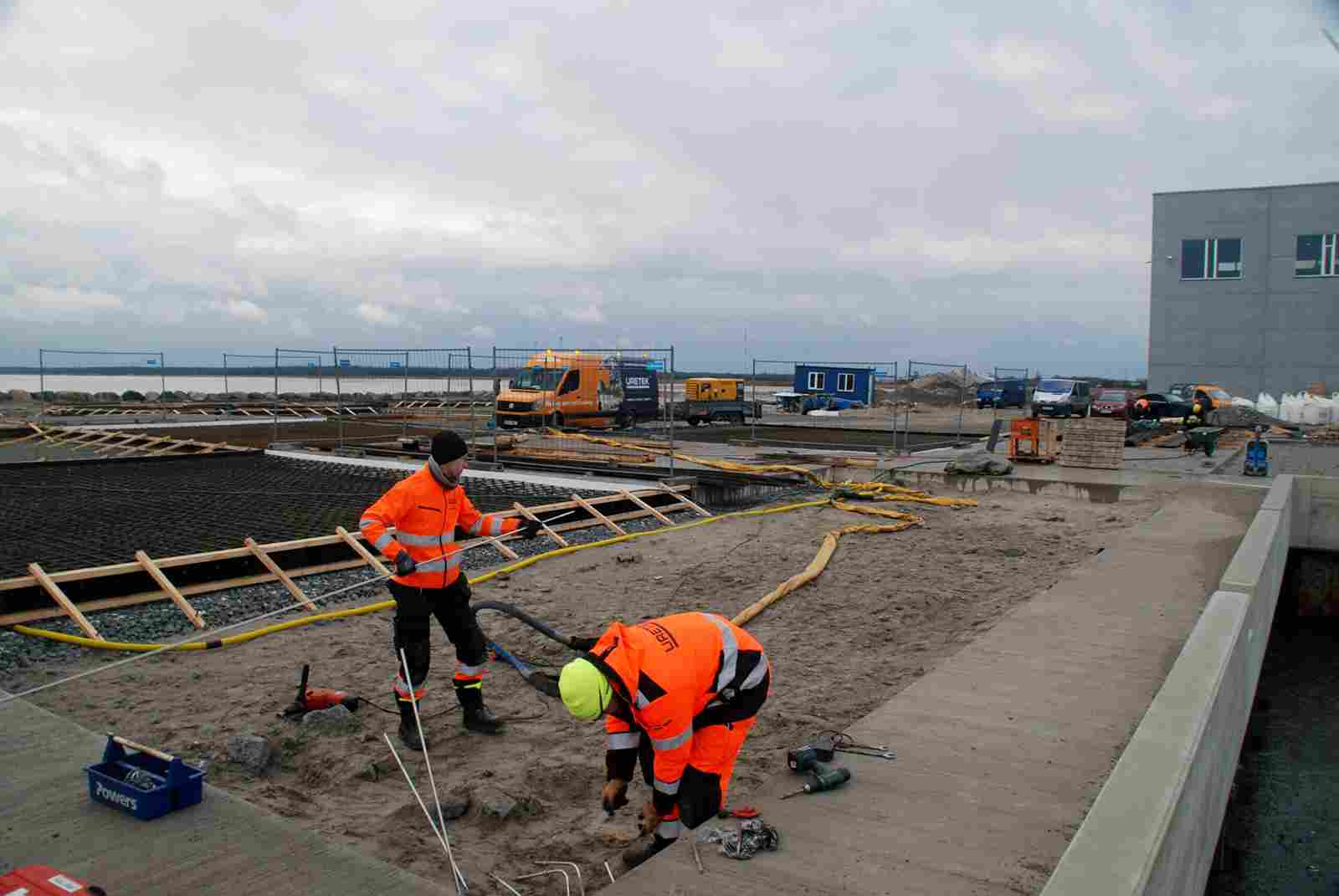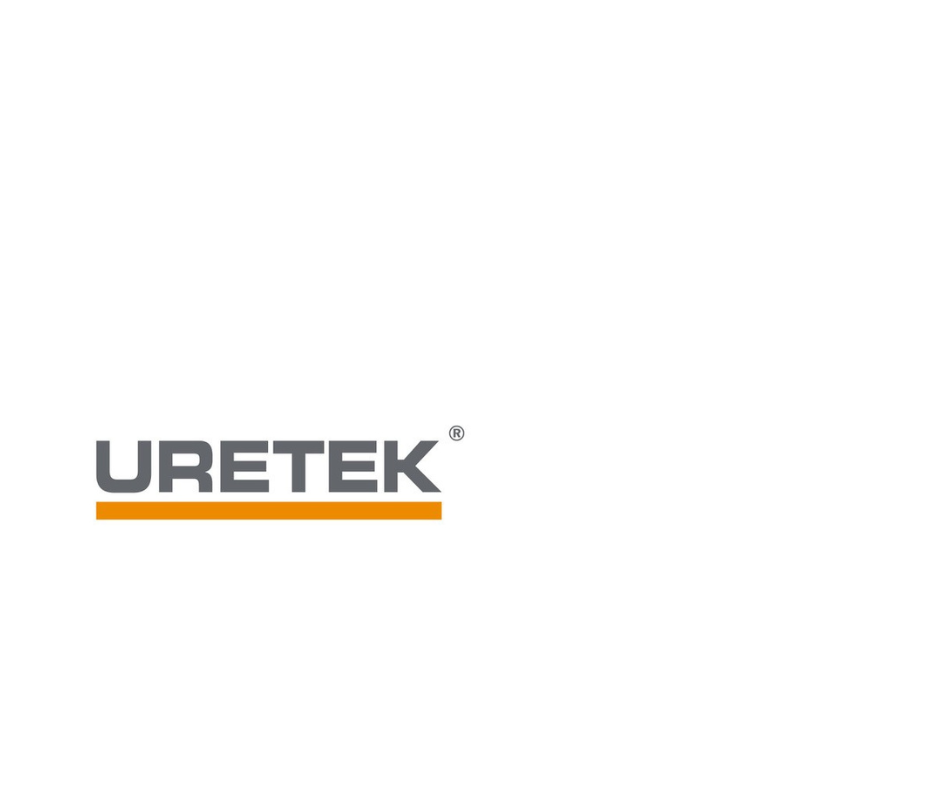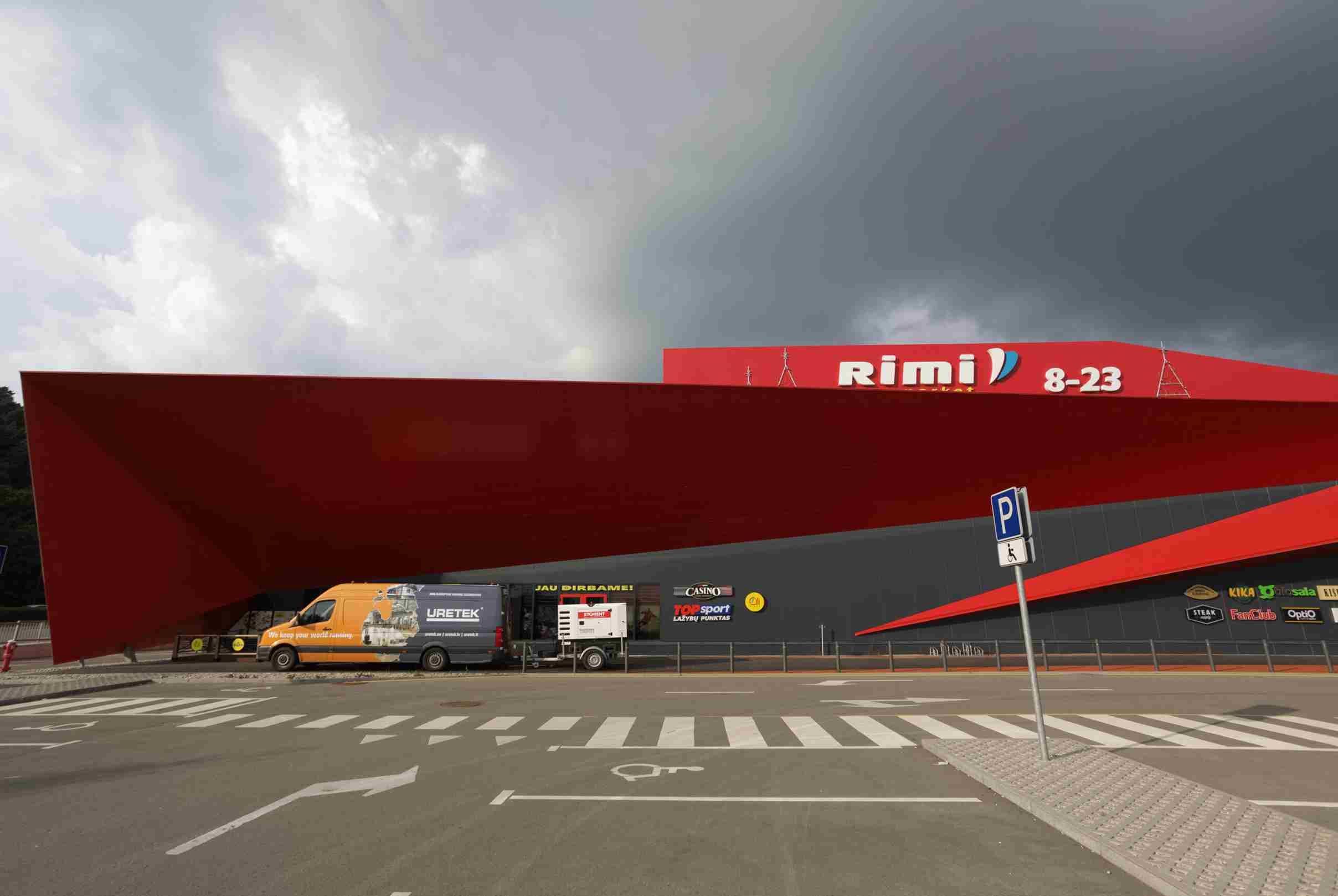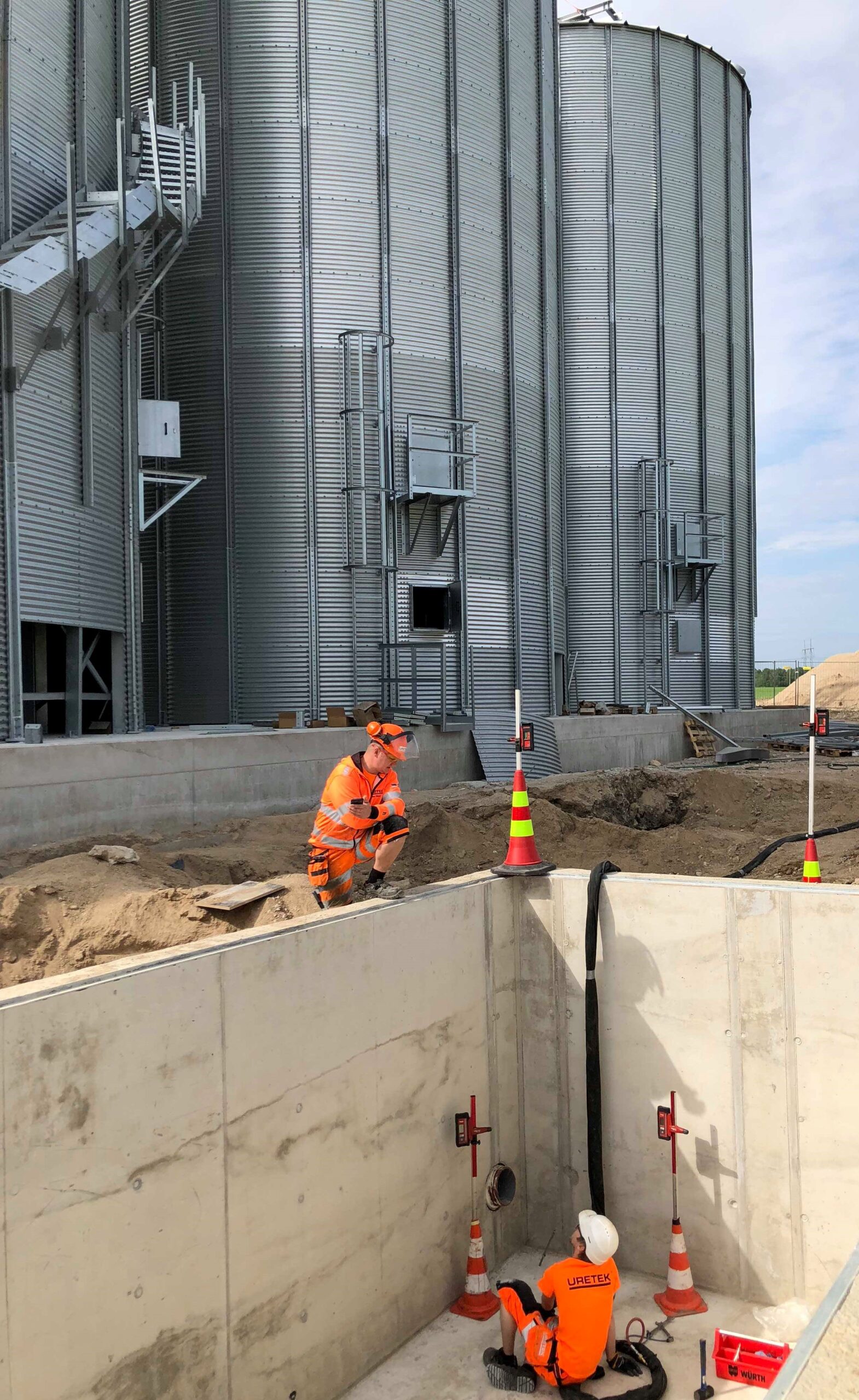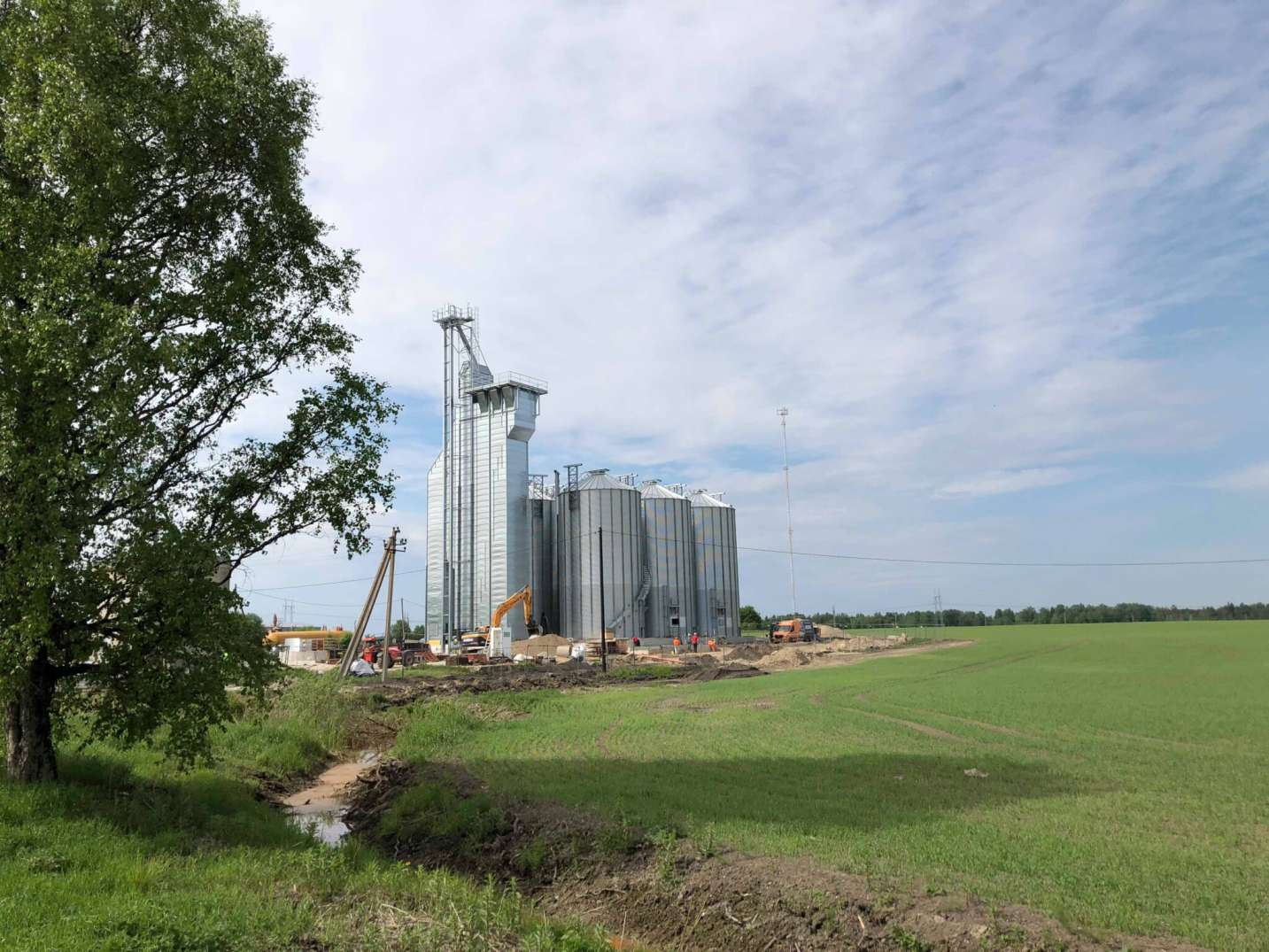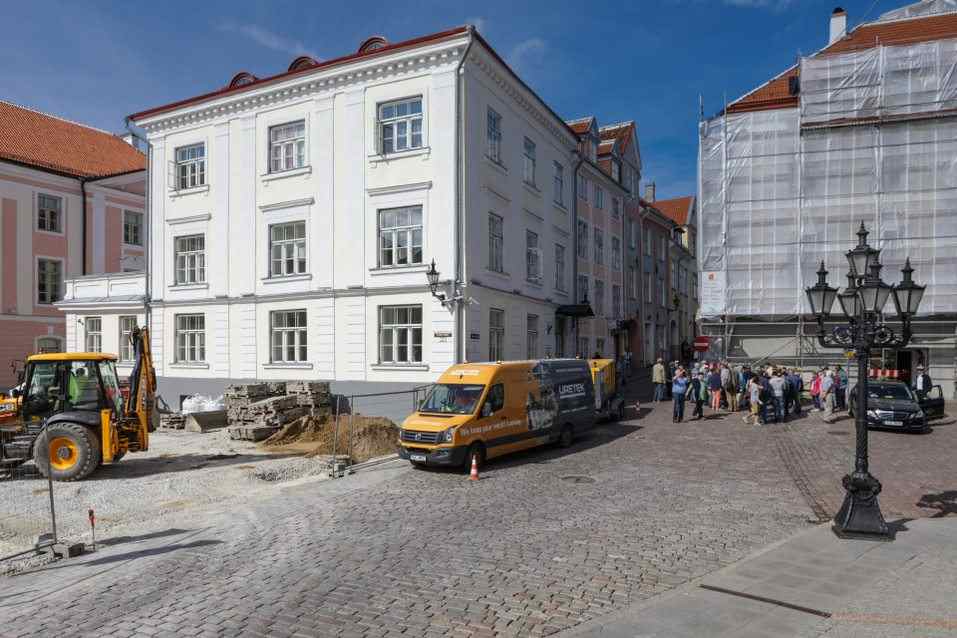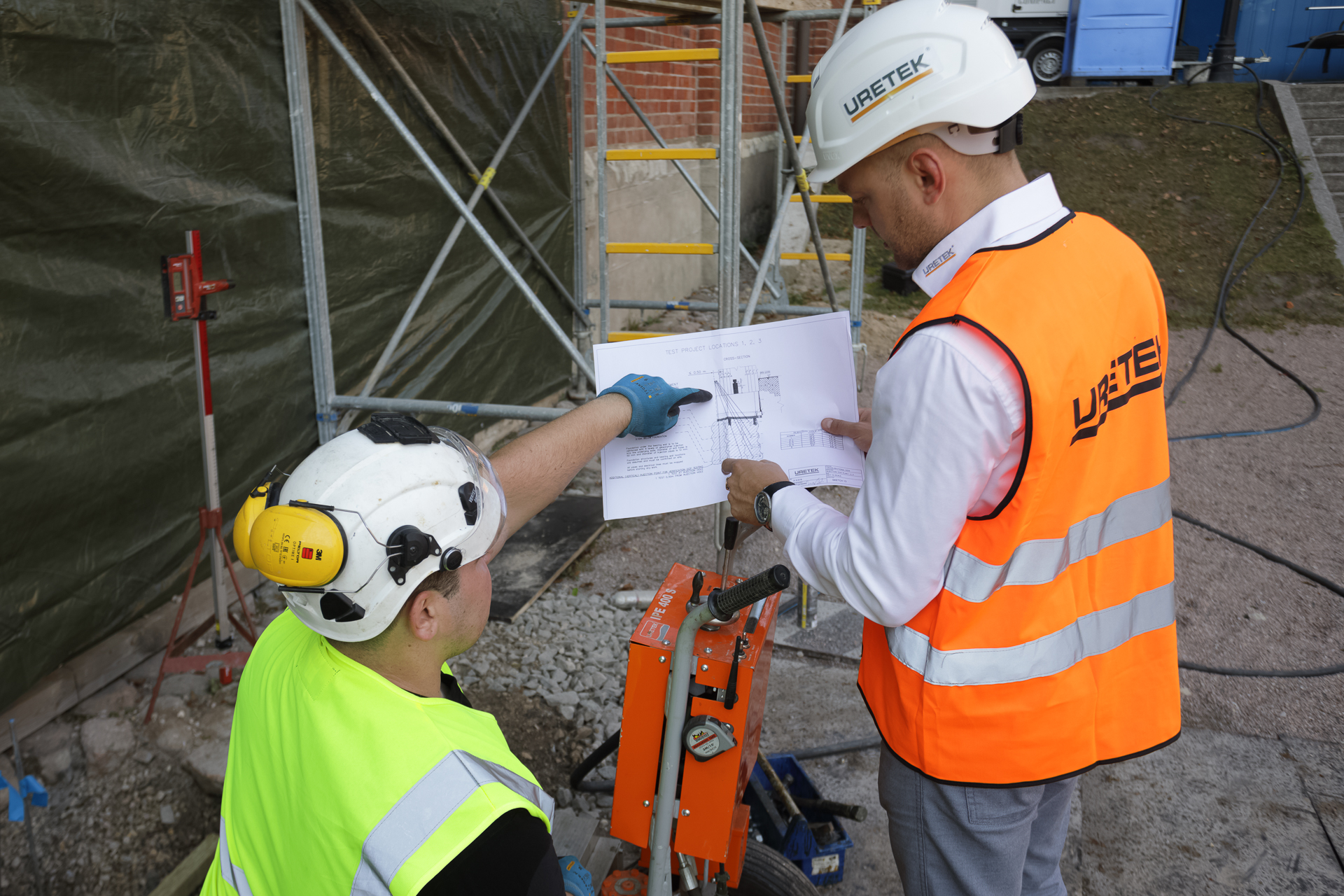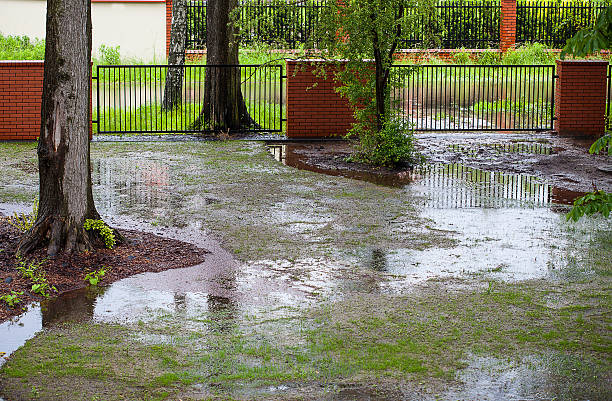Technology
Lifting and stabilisation of port facilities
Geopolymers do not react with water, they remain stable even in humid environment. This allows using geopolymers for levelling and strengthening of jetties, embankments and berths.
URETEK geopolymer resins are suitable for stabilising infrastructure objects of seaports and river ports. In order to lift concrete structures and stabilise them, geopolymers can be injected under the concrete slabs of jetties, embankments and berths as well as in water-saturated subsoil of these structures.
Strengthening the soil under jetties, embankments and berths
Construction of concrete jetties and embankments generally requires installation of a vertical support wall that would retain filling material necessary for installing concrete slabs. Due to constant water influences, surface water level changes dynamically, meaning that there are also changes in the moisture content of soil under the structure.
As a result of that, filling material can slowly become more compact and horizontal surfaces are subject to movement and uneven subsidence. Concrete slabs of jetties, embankments and berths are also affected by heavy duty vehicles, gantry crane, transporters, loaders and other additional loads. Total weight of port loader with transmission container reaches up to 100 tons. Naturally, such weight causes increased compaction of the filling material under concrete base and soil under the entire structure. Thus, different sections of concrete surface may suffer from uneven subsidence.
In order to level concrete slabs and stabilise the structure of jetties, embankments and berths, filling material and subsoil of the structures must be strengthened. Load-bearing capacity of soil is improved with geopolymers in stages and without disrupting port operation.
Lifting and stabilisation of concrete slabs
URETEK geopolymer resins are suitable for levelling and strengthening of parking lots and manoeuvring areas for heavy duty vehicles, loaders and gantry cranes. Furthermore, geopolymers can be used to repair concrete floors and covers of port warehouses and docks, the condition of which has deteriorated due to exposure to water.
Concrete slabs are levelled by using Slab Lifting method. For more efficient stabilisation of port structures, Deep Injection method is used. It enables strengthening of soil under the structure. Geopolymers force out excess water, thus increasing the load-bearing capacity of soil.
Advantages of URETEK methods
Formerly, repair of concrete surfaces meant removal of all cover slabs, compacting of filling material and reinstallation of concrete slabs. In that case, major repairs are similar to new port construction, involving not only high cost, but also long-term stoppage of port operations, causing additional costs and loss.
URETEK technology makes it possible to perform work without dismantling concrete slabs and interrupting port operations. Materials and equipment required for geopolymer injection fit in a single truck. For injecting geopolymers under concrete slabs and deep in soil, holes with diameter of 12–16 mm are drilled. These holes are simply closed later. Stabilised and repaired sections can be used 15 minutes after completion of works.
Keywords
Comparison of cementing (and silicating) and URETEK technology. Pros and cons of cementing.
Compared to cement mixtures, URETEK materials are more elastic, which is a huge advantage.
As the soil expands and shrinks (depending on its moisture content), cement mixture crumbles and loses its properties, turning to dust. Use of cement mixtures and silicating is not possible in case of soil with porous structure and high content of organic substances. Depending on soil acidity and humidity, the time required for concrete and silicate mixture to harden can be rather unpredictable. Cement mixtures exposed to impact and vibration loads turn to dust. URETEK materials do not have these problems and they are not affected by chemical composition of soil. All components necessary for reaction are mixed together during the injection process, reaction time can be predicted and controlled, and reaction does not depend on external factors.
Soil layers can expand and shrink as their moisture content changes. When strengthening foundation with concrete, a rigid structure is formed, which rises and falls according to changes in soil water content. Constant vertical and horizontal movement of soil leads to occurrence of cracks and damage to the structure under the building. Uneven soil layers further increases the risk of site destruction.
Silicating and cementing is prohibited in various soil types, e.g. porous soils due to surface water, which makes it impossible to achieve required properties by using these formulae. Due to chemical composition of soil, silicate and cement mixtures might not achieve required durability and turn into powder, which further deteriorates the load-bearing capacity of soil.
Advantages of cementing (and silicating):
- Presence of traditional engineering technology and knowledge;
- Wide technical application, as there are many theoretical studies available since post-war years.
Disadvantages of cementing (and silicating):
- it can be slow, because the result is not predictable even after project approval;
- dirty work, because cement behaviour in its liquid state is not predictable. This can be seen when taking a look at the overalls of cementing technician;
- labour-intensive process that requires numerous staff;
- outcome – whether the solution works or not – can be checked only after a certain while. This means that it is a long-term project in most cases;
- cementing is not an option in loamy or other soils that move and change over time, because it does not eliminate the reason of the problem;
- outcome of levelling and lifting of structures is not predictable.
URETEK’s solution:
This is a modern and proven method for strengthening foundation (used since 1978). Method encompasses injecting ecologically neutral resin under the foundation through small holes (diameter of 12–32 mm). Resin is inserted in soil, where it expands and hardens, filling all voids and cavities. During resin injection the building or other structure is lifted higher.
Process is closely monitored by technicians who use very sensitive laser equipment. Resin formula is carefully chosen according to climatic and soil conditions and purpose of works.
Advantages of URETEK:
- clean workspace: no need for excavation works, meaning that there is no dirt and waste;
- operative and fast: most projects are carried out within two to three days;
- works do not need major preparations and clients can continue using the site during works.
This method for strengthening foundations has been tested worldwide for more than 35 years and it will protect your object in future.
Keywords
Elimination of floor subsidence in stores and warehouses without changing their opening hours
Concrete floors of large warehouses, supermarkets and logistics centres may also suffer from subsidence or tilting
Modern URETEK geopolymers injection method allows lifting concrete floor slabs and stabilise them without vacating the premises and disrupting daily work.
Floor slabs in large warehouse and commercial areas are designed in view of daily impact of stationary structures. Concrete floor must also handle loads caused by loading machinery and other warehouse equipment. In case of exceeding permitted maximum static or dynamic loads or in case of changes in soil properties under the structure (weakening of soil due to changes in surface water level, breakage of water or sewerage pipes), it is likely that floor slabs sink or tilt.
The damage described above can cause minor discomfort resulting from changed position of commercial and warehouse equipment, but it can also lead to accidents and situations that endanger human health and life.
Complexity of lifting and stabilising concrete slabs
Unfortunately, subsidence of concrete floor in a warehouse or commercial premises is not always noticed in time. Considering that restoration of concrete floor and strengthening of the soil under the floor requires dismantling of concrete slabs when using traditional methods, the repairs are often postponed as they cause major loss to the owners of premises resulting from long-term work stoppage.
Instead of applying systemic measures, owners often seek temporary solution by using all kinds of supports and bases. However, such an approach to the problem may obviously lead to unpleasant consequences.
Lifting and stabilisation of floor by using geopolymers
Sunken sections of concrete floor can be lifted and the soil under the structure can be strengthened by using URETEK geopolymers injection method.
In that case, there is no need for dismantling concrete slabs, involving heavy machinery or performing earthworks. In order to stop subsidence of concrete slabs and levelling them, geopolymer material has to be inserted deep under the floor in the soil under the structure (Deep Injection method) or in the space between soil and concrete slab (Slab Lifting method).
Immediately after injection, geopolymer resins expand and take up all vacant space in the soil under the structure, compact the soil and harden within only 15 minutes. URETEK geopolymers injection technology allows increasing compressive strength of soil up to 10.6 МPа.
Injection can be done without dismantling sunken slabs. It requires drilling just a few technical holes with diameter of 16mm in the concrete for pipes intended for inserting geopolymer material. Meanwhile, URETEK equipment can be located up to 120 m from the actual place of injection.
Geopolymer material is inserted in soil through special hoses that can easily be moved in the room between shelving and other equipment. Thus, it is not necessary to vacate premises from goods and equipment. Furthermore, the hardening speed of URETEK geopolymer resins allows lifting and stabilisation of concrete slabs at night. But warehouse or store does not have to stop work even if the floor needs to be lifted during working hours. Due to mobility and compact dimensions of the equipment, there is only minimum disturbance in daily operation.
Advantages of URETEK technology
The process of lifting and levelling sunken concrete slabs is monitored in real time. This is done by using special laser levels with measurement accuracy of ± 1 mm. Ground floor slabs can be lifted by maximum 20 cm. After restoration of former floor height, cracks can be eliminated in partition walls supported by sunken slabs. Restoring floors by means of URETEK method allows saving up to 25% compared to traditional methods.
Keywords
Comparison of concrete works and URETEK technology. Pros and cons
Causes of deformation in building foundation
Formerly, foundation was repaired by cementing, now a new solution is used – URETEK technology. It represents a rapid and secure alternative to concreting and piling of foundation. URETEK technology deploys unique strengthening methods for foundation repairs, somewhat similar to advanced surgery. This technology allows eliminating the reasons for structural subsidence and deformation by re-levelling slab covering of concrete foundations, strip foundations, pile foundations and floor slabs and even solving problems related with access roads.
Work process
URETEK resin is inserted in the soil under a structure through small holes (usually with diameter of 16 mm, only 12 mm in case of interior works).
Then URETEK resins expand, filling cavities, compacting subsoil and stabilising the foundation (or other load-bearing structures), thus allowing re-levelling of the house.
For optimum results and safety purposes, the pressure generated in the course of expansion is constantly checked with laser equipment.
- Cracks in the walls usually shrink. However, in case of brick wall, it only requires secondary treatment of joints with mixture or joining with special fixture, patching and painting of cracks in case of plastered walls.
- Windows and doors will usually function normally again.
- Gaps between floor slats and fixed floors generally disappear as well.
Guarantee
Materials used comply with strict ecological and safety requirements and have been designed specifically to resist drying and subsidence. Quality is guaranteed for more than 50 years.
Strengthening methods using concrete works
Over many years, concrete works have been used as a classical method for foundation repairs. Compared to traditional concrete works, the advantages of URETEK technology include speed, cleanness, durability and predictability, economic efficiency and an opportunity to avoid interfering with normal use of the structure.
URETEK material ensures durable soil stabilisation and building re-levelling faster than concrete works, where nothing can be guaranteed. Now it is possible to heave a house to desired height within a day or two, or a couple of weeks, depending on its construction technology. Furthermore, resin injection does not generate waste, there is no need for excavation works, water, cement or concrete.
It is important to mention that injection works do not require vacating entire room. Unlike concrete works that need lots of preparation and interior works, URETEK technology does not need any of that. Small holes (diameter of 12–14 mm) can be drilled between cover plates and even through carpeting and there is usually no need for moving the furniture.
URETEK method is ideal for foundation repairs even in case of clay and other porous soils, as it solves subsidence problems. The method ensures load-bearing capacity of substrate and uniform properties of load-bearing layers.
In the course of concrete works, it is necessary to improve poor soil conditions, such as unbound, dusty and wet substrate or substrate containing poorly compacted filling material. This is due to the reason that extra weight of concrete may further aggravate the situation.
Cost of concrete works
Besides being more convenient, safer and durable, URETEK injection solution is usually also cheaper than traditional concrete base.
The cost of concrete works depends on many factors, including:
- Location of building,
- Actual cause of the problem,
- Properties and condition of the soil under a structure,
- Type and profile of building foundation,
- Surroundings, e.g. access to the plot, adjacent buildings and support walls,
- Unknown, unpredictable condition of the soil under a structure,
- Quantity of required material,
- Time spent on work.
If only one corner of the house requires re-levelling, concrete base may be cheaper, but it may still lead to further problems over time. For instance, new cracks may develop in the house if concreting is performed in only one section of the foundation, not to mention additional load on the base affecting the substrate that was used to former loads.
In most cases, resin injection is cheaper than other methods, including concreting of foundation.
Keywords
Strengthening of soil at the shores of natural and artificial waterbodies
URETEK geopolymers stand out for their ability to preserve their properties even in humid environment. Due to their special composition, geopolymers are protected against water. Therefore, geopolymer resins can be used for strengthening the shores of waterbodies.
Water gradually breaks the materials it encounters. Such natural process is called water erosion and that is why special attention should be paid to strengthening soil when erecting buildings near shoreline. This applies also to artificial waterbodies, e.g. ponds-reservoirs and wastewater treatment plants. Accidents resulting from soil erosion or collapsing embankments can be avoided when using URETEK geopolymers injection technology.
Special features of strengthening shores
In many cases, strengthening of soil near waterbodies and securing the shoreline is considered insignificant. Rather frequently only temporary solutions are used to strengthen the shores of waterbodies, e.g. covering eroded area with crushed stone or other filling material.
As a result, failure to reconstruct unsafe section may create a need for regular repairs of shoreline, which also means significant costs. Equally expensive is the traditional method of embankment repairs, which requires using special heavy-duty machinery and earthworks.
Alternative solution for proper strengthening shore-side soil is URETEK geopolymers technology. It does not require using heavy duty vehicles. Geopolymer resins can be injected by using small mobile devices that allow inserting material in soil through drilled holes with diameter of 12–16 mm.
Process of strengthening soil
Washed or eroded sections of shoreline and destroyed embankments (such as stone dykes) are restored by using Deep Injection method. Geopolymers are inserted in soil according to scheme starting from the depth of 1.5 m and deeper. After series of several injections at different depths, a solid waterproof wall is formed in soil.
Geopolymers achieve required strength with only 15 minutes. During that time, they spread across the soil and form a waterproof barrier that resists rather great loads. When exposed to water, geopolymers do not change and preserve their waterproofing properties for a long time.
Geopolymers can be injected not only in the shore-side soil but also directly in the embankment made of stones and rocks. In that case, geopolymers fill the voids between stones and for uniform solid structure.
Ecological safety
Huge advantage of URETEK geopolymer resins consists in their ability to achieve great durability even in excessively moist environment. Meanwhile, geopolymers are ecologically safe and absolutely inert materials that do not endanger ecosystem of the waterbody.
Keywords
Special features of buildings with pile foundation
Advantages of pile foundation include affordable price and opportunity to get effective results in very short time.
Screw pile resembles a pipe with blades. Inserting such pipe in soil leads to better stability of structures and buildings. Using piles provides the foundation with great resistance, it is not affected by surface water and it does not sink. In terms of quality and financial gain, pile foundation is often considered better than technically complicated foundation replacement. Moreover, foundation strengthened with piles creates an opportunity to build additional storeys above the foundation.
When does it become necessary to use screw piles?
Foundation can be strengthened with screw piles under any conditions, regardless of the location of the building. Foundation with screw piles allows erecting metal and concrete structures, whereas it involves nearly no earthworks. Strengthening of foundations located on complex subsoil often exceeds all expectations, because works are performed rather quickly and at low cost.
Currently, using screw piles for supporting foundation is considered the most optimal and universal way to increase load-bearing capacity of structures quickly and with high quality, so that they would endure any external factors for a long time.
What are the problems solved by using screw piles?
Main function of screw piles is to support structures in problem areas and unstable soil. Due to wide blades at the bottom of piles, it is possible to further increase the bearing surface in soil. Screw piles ensure resistance to pressure exerted by force exceeding 20 tons.
Usually, piles are used for achieving the following goals:
- Increased load-bearing capacity of multi-storey building. Piles can be used to support a building, foundation of which cannot be fully replaced.
- Strengthening of old foundation to allow building more floors in the future.
- Stabilisation of sunken soil under the structure: pile is screwed in soil, thus remarkably increasing its stability.
Are there any more contemporary methods for strengthening foundation?
Screw piles represent unquestionably popular method for strengthening the load-bearing capacity of a foundation, but there are new technologies that allow different approach. URETEK’s new Deep Injection method ensures strengthening of foundation by stabilising the soil on which the structure stands.
For that purpose, special geopolymer mixture is inserted in soil. As it expands, it forces water out of the soil and fills all voids. Problem soil is levelled, subsoil is stabilised. Method allows remarkably quicker completion of repair works, it excludes earthworks, even in case of repairs performed in unsafe buildings.
Keywords
Stopping subsidence of concrete pools and elimination of cracks
Water level may drop in concrete pools. In hot summer, it is sometimes explained by natural vaporisation. But it may also result from occurrence of cracks in pool structure due to foundation subsidence.
Problem can be solved by using geopolymers injection.
Unlike other structures, pool structure does not prescribe even minimum subsidence of concrete frame. If the pool subsidence has occurred due to insufficient compaction of soil or excess humidity of the soil under the structure, cracking of concrete is inevitable. As a result of cracking, water starts to leak gradually. This, in turn further aggravates the condition of soil around the pool. It may become unsafe and the site cannot be used any more.
When repairing a pool, just patching the cracks is not enough. It does not remove the initial cause of damage. If the cracks occurred due to weakening of soil under the structure and subsidence of pool frame, it is necessary to address the problems with soil and foundation first.
In that case, soil is strengthened before eliminating cracks, foundation lifted and stabilised if necessary. It is worth noting that when using modern URETEK geopolymers injection methods, the work cycle lasts only a day or two and it does not require earthworks or concrete works.
Deep injection
Cracks in concrete pools can be eliminated by using Deep Injection method, which allows filling cavities and voids in the soil under the pool with special geopolymer resins. After reaching the soil, geopolymers expand and harden quickly, exerting vertical pressure. That way it is possible to strengthen weakened and excessively humid soil under the structure.
Furthermore, geopolymers can be used to stop pool subsidence and stabilise its position, or even lift it to its former height where necessary. Due to their structure, geopolymers do not react with water, but force it into surrounding soil. Therefore, geopolymer resins not only strengthen the soil, but also function as waterproofing material.
Cracks in concrete can be patched only after strengthening soil and stabilisation of foundation.
Works algorithm
Geopolymer resins are injected through special holes (diameter of 12–16 mm), drilled in concrete or soil around pool’s perimeter. Holes are quickly closed after completing the injection.
URETEK geopolymer resins are not destructive. They are suitable for strengthening soil, lifting and levelling concrete structures. Everything related to altering the position of concrete frame is monitored in real time by using laser level (precision up to ±1 mm).
Due to their physical and chemical properties, geopolymers remain stable for a long time, including in humid environment. Material is chemically inert, ecologically safe and tested across the world during long term use.
Keywords
Huge impact of extreme weather events on the foundation and the soil under the structure
Extreme weather events, natural disasters, long periods of drought, rain and cold have strong effect on the soil under the structures and on the foundation.
The summer of 2018 was extraordinarily warm, and the heat lasted for a long time. At the same time, January was one of the coldest in history. While some people were exhausted from record high temperatures, other regions suffered from flooding. Rainstorms and cyclones had a devastating effect on many buildings and population in general.
How weather phenomena affect soil
Soil types vary by properties and their response to weather conditions, and they may have serious impact on load-bearing structures of buildings. Houses built on loose soil, sand and reactive clays (rising soils) may suffer the most due to seasonal or extreme rainfall, floods and drought (or cold).
Reactive clay expands when exposed to moisture and shrinks when drying. This is accompanied by soil splitting during long periods of drought and expansion during humid periods. Clay loses its porous structure as a result of freezing and expansion in cold weather.
Sand and loamy soils tend to subside due to rainfall, because water flushes off small particles and larger particles sink.
Filling material used in construction often consists of soil, but also other materials, such as brick or concrete fragments, also crushed construction materials. When water finds its way through such material and flushes away minor particles, it may cause the soil to sink. The effect of the process can be visually depicted as recess in the ground, whereas it may further deepen due to poor soil compaction and general condition of surrounding soil. In case of changes in the condition of soil under a structure, it can no longer support the foundation and the structures gradually start to sink. Building sinks either partially or entirely, but in any case, unevenly. This is called soil subsidence.
Another important factor is humidity level of the soil. For instance, clay soils in a region with moderate temperature are humid in general. But due to lasting dry weather, soil loses humidity and shrinks, causing the soil to sink. At the same time, such soil absorbs lots of water in rainy season or becomes impermeable. Along with freezing or (subsequent) melting, the soil may also cause risk of subsidence. In the event of a flood or broken utility line, water may carry away or scatter the soil, resulting in erosion and subsidence. All that can cause serious damage to the foundation and load-bearing structures of buildings and special structures.
Extreme climate conditions have become more frequent all over the world. For example, summer with record-breaking high temperatures affected the foundations of many buildings even in regions with mild marine climate (Great Britain). Continuous warm temperatures caused the surface water to dry out, which in turn caused subsidence of buildings. Therefore, insurance companies received from house owners exceptionally many complaints and claims regarding buildings subsidence.
How to combat soil subsidence
Fortunately, there are methods that allow quick, effective and sustainable protection against soil subsidence. Innovative solutions offer an alternative to traditional invasive and labour-intensive methods that use concreting of foundation or piles.
Patented URETEK resin injection technology does not require troublesome excavation works or cause major discomfort, because residents can often continue to live in the house while the works are performed.
Keep in mind that in case of discovering signs of subsidence you should immediately consult with specialists-designers or engineers-geotechnicians and obtain information and facts necessary for choosing appropriate solution.

